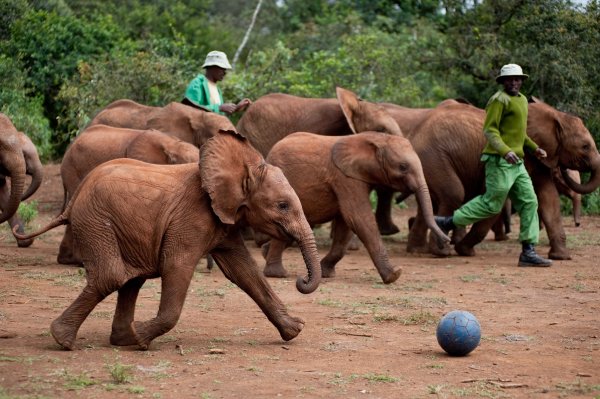 Step 1: Go, IMAX! The brilliant IMAX technology works its magic again with the fascinating and heartwarming nature tale Born to Be Wild.
Step 1: Go, IMAX! The brilliant IMAX technology works its magic again with the fascinating and heartwarming nature tale Born to Be Wild.
Step 2: Start with a dedicated idea. This documentary, narrated by the always good Morgan Freeman, follows the efforts of two animal activists. In the lush rainforests of Borneo, world-renowned primatologist Dr. Biruté Mary Galdikas has set up a compound where she nurses orphaned baby orangutans, whose mothers have been killed, usually by some form of deforestation. Then across the rugged Kenyan savannah, celebrated elephant authority Dame Daphne M. Sheldrick does the same thing with baby elephants, whose mothers have been killed by poachers. These women and their trusted teams rescue, rehabilitate and return these incredible animals back to the wild — and we get to watch with wonderment on how they do it.
Step 3: Love the orangutans. Born to Be Wild is only 40 minutes, but in that time you get to know the characters intimately. With Dr. Galdikas, we see how her mostly female team bonds with the orangutans. Adult orangutans are generally solitary creatures but as babies, they cling to their mothers, rarely ever touching the ground. In the compound, these expressive primates wrap themselves around their human surrogates and grow to love them as much as if they were monkeys themselves. Dr. Galdikas also keeps in touch with some of the adult orangutans she has raised, who are now happily surviving in the wild. In one scene, she shares a bowl of noodles with one.
Step 4: Love the elephants. With Dame Sheldrick, her team is mostly male, and they, too, form close attachments with the baby elephants. Elephants are far more social than orangutans and only feel truly comfortable when they are surrounded by other elephants and their human friends. Most rescued baby elephants have been traumatized when they are brought into the camp, having witnessed their mothers killed and shunned by the male elephants, so it takes a lot of TLC to get them to trust the humans. In fact, each handler assigned to an elephant sleep with their charge so to make the animal feel safe. Then when it comes time for the elephants to go back into the wild, Sheldrick takes the elephants to an even more remote location, where the animals stay for another three years. In that time, adult elephants – who were raised by Sheldrick but are now living in the wild – come back to this camp and actually help rehabilitate the younger elephants so the transition goes smoother. It still kind of brings a tear to my eyes.
Step 5: Go, IMAX… again! The best part is watching Born to Be Wild in an IMAX theater. Filmmaker David Lickley apparently had a time of it getting all that equipment into these remote places, especially in Borneo, but the captured images are truly breathtaking and spectacular. Adding the 3D element is also a must. At one point, one of the orangutans looks close enough to touch. I complain about all the friggin’ 3D movies out there and having to wear those glasses, but when in an IMAX theater, the technology still astounds me.
Step 6: Be an animal lover. If you’ve ever thought about leaving the comforts of society and going into the wild to study and help animals, Born to Be Wild will definitely urge you in that direction. There is something so selfless and amazing in seeing people dedicated to preserving natural wildlife – and focusing on such adorable animals as orangutans and elephants is just a plus.


